Plexiglass Is It Considered a Acrylic for a Art Project
This post may contain affiliate links. We may earn a minor commission from purchases made through them, at no boosted price to you.
In this blogpost you will larn everything about creating fine fine art with epoxy resin. We'll tell y'all what resin really is, and what you have to consider when working with it. In addition, you lot volition get a detailed step past step tutorial for creating your first resin artwork.
Table of Contents
- one What is Resin or Epoxy Resin?
- ii What is Resin Art?
- three Required Supplies
- 4 Safety Precautions when Working with Resin
- 5 Calculating the Required Amount of Epoxy Resin
- 6 How to Make Resin Art – Step by Footstep Tutorial
- half-dozen.one Grooming of the Workplace and Painting Base of operations
- 6.2 Thoughts on Resin Painting Composition
- 6.3 Mixing and Coloring Resin
- half-dozen.4 Casting the Resin Painting
- seven Casting Further Layers
- 8 Repair Amercement in Your Resin Art
- ix Cleaning the Tools
- x Sealing Resin Fine art with Epoxy Resin
- 11 Tips and Tricks
- 12 Inspirations for Your Epoxy Art
What is Resin or Epoxy Resin?
In artistic terms, resin refers in particular to epoxy resin. This is used to create art objects and consists of a two-component system, the resin and the hardener. The components are mixed together, which leads to a chemic reaction after a short time – the mixture and then hardens.
After hardening, it tin be farther processed in diverse means. For example, information technology tin be sanded or polished and even painted. It is fifty-fifty food condom, even though many manufacturers refrain from certifying it – mainly for financial reasons, considering certification is quite expensive.
Resin is a especially versatile fabric that is non only used in fine art. Gunkhole builders, carpenters and jewelry manufacturers also swear by its durability, ease of processing and numerous blueprint possibilities. It is also weather-resistant and has high adhesive properties on numerous surfaces.
Apart from that, unique pieces made of epoxy resin are a existent feast for the eyes. The cloth has a smooth, articulate surface and can exist used in many different means in arts and crafts.
What is Resin Art?
Resin Art describes the art course of creating fine art objects with epoxy resin. The term refers to all facets of this art. Resin tin can be used to design paintings, also as to produce varnishes, resin jewelry, petri dishes and various other castings of any kind.
The latter is also known as Resin Casting. Beside classical clear castings you can as well include in your cast all kinds of objects like natural materials, stones, glitter and many other things. The artist tin really let his imagination run wild. The results are cute fine art objects that are as unique and individual as the artist himself.

Required Supplies
To start with resin art, you demand some specific materials and equipment. When choosing your resin you should besides not be besides frugal. It is worth investing in a high-quality resin from well-known manufacturers – cheap epoxy resins are often not crystal clear but milky and yellowish afterwards. It would be very annoying if your painstakingly cast painting looks cloudy after a few weeks and loses its color brilliance.
We recommend the following materials for your start with Resin Art
Best Resin for Resin Art
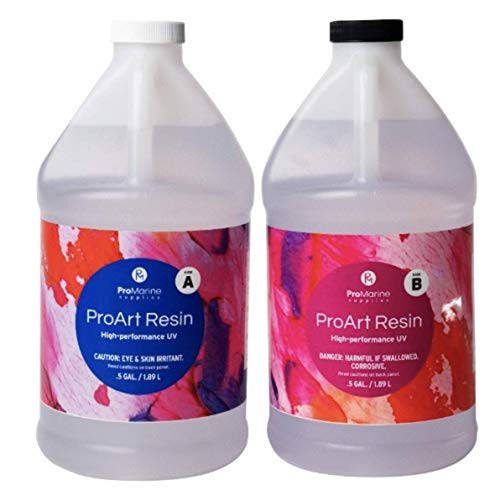
- Specifically designed for art projects, excellent colour stability
- Very easy to apply with 1 : ane mixing ratio, 100% solids, hard-trounce terminate
- High gloss and crystal clear, your all-seal solution, first-class air release
View on Amazon

- Specifically designed for art projects, developed with professional artists
- Heat resistant, scratch resistant, food condom, maximum UV resistant, water resistant
- Compatible with alcohol inks, acrylics, silicone oils, metallics, dyes, pigments
View on Amazon
Epoxy Resin pigments and color pastes
Painting and surface training
Resin Art – Mixing

It is important non to use canvas as a painting base of operations, because the resin is likewise heavy for this. It would run together in the center and let the canvas sag, so that the result is undesirable. Suitable painting surfaces are wood, plexiglass, drinking glass or metal. Besides various household objects similar cutting boards and wooden bowls tin can be refined with epoxy resin. Even pieces of furniture such as tables and kitchen worktops can exist covered with resin.
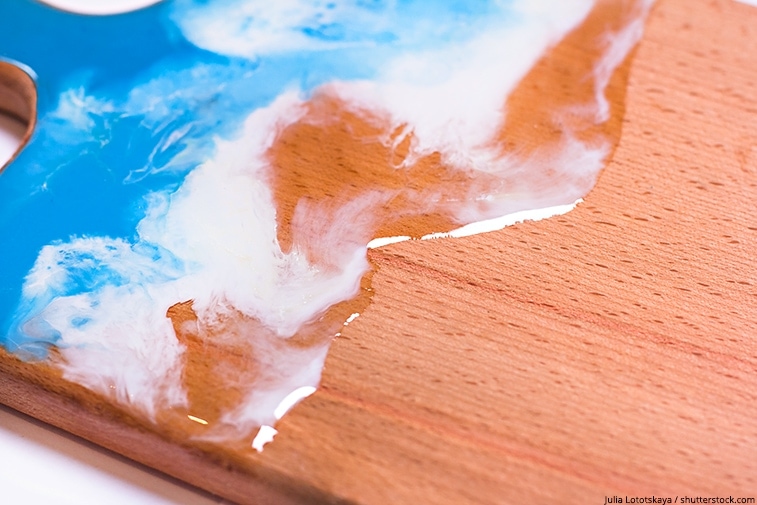
Equally far as colors are concerned, you lot are relatively free to choose. Online you will find a wide range of resin paint which is suitable for epoxy resin art. Y'all can employ liquid colors, pigments in powder form, as well as airbrush colors. Exist careful non to dilute or mix your paints with h2o. This would lead to an insufficient hardening of the resin and brand it cloudy. You should always mix the colors directly with the resin in a cup before utilize.
Safety Precautions when Working with Resin
An important bespeak when working with resin is that you protect your surroundings sufficiently. This means that you lay out large areas of protective foil to protect the floor, unless y'all work in your own studio where you don't intendance how information technology looks afterwards. With epoxy resin art, it is quite possible that something will spill. Since the material solidifies relatively quickly and is really hard later, information technology is very difficult to remove information technology from floors and piece of furniture. So, protect the areas that are not going to be covered with resin with a protective foil or several layers of newspaper.
It is too very important to air the room well. Your skin and optics should also exist protected from contact with the epoxy resin, as liquid epoxy resin is a toxic material. (Hardened and cured, it is however completely harmless)
Therefore wearable disposable nitrile gloves (NOT latex gloves!) and long-sleeved article of clothing. If resin gets on your peel, clean information technology immediately with vinegar and then again thoroughly with lather and h2o. Smoking, eating, and drinking in the immediate vicinity of resin paint and resin should exist avoided. Always wearable respiratory protection and safety goggles when working with resin.
Tip: Do non mix as well much epoxy resin in a container, so that it does not spill over the edge when working .
Before you lot start working with resin, it is a good thought to summate the amount of resin needed. Nosotros recommend our resin calculator for determining this. To brand sure that yous have enough resin available in case of spills or premature hardening, yous tin circular up the calculated amount. To dare to arroyo a new painting technique or art movement without knowing the art is ofttimes associated with an doubt. If you do not succeed, this leads to frustration and sometimes even to abandoning the chosen art form. Here you will find a detailed step by step resin guide to assistance you lot become started with your first resin artwork. Even Resin Fine art paintings with one layer of resin look very noble. Boosted layers, however, give the paintings a very special depth. To apply an extra layer of resin to your painting, y'all must first let it dry for about five hours. At this time the resin is a piddling scrap gummy, only is already a little hardened. If you desire to apply some other layer of resin when the outset one is already completely dry out, you take to sand it a niggling bit beginning so that the fresh resin can bond well with the lower layer. After your resin fine art has stale, you lot may discover some defective areas, such as slight dents or even holes. This is caused past insufficient coverage with the epoxy resin and occurs if y'all take used too little resin. Sometimes defects also appear if too much resin has run down the sides of the painting basis. Silicone oil and Resi Blast can besides promote the germination of dents. If you have discovered whatsoever flaws, you will have to sand the painting. Utilize a fine grain and go along very carefully. Then you lot tin can utilise a new layer of epoxy resin. If y'all have used silicone oil or Resi Smash, you should also clean your resin artwork with booze before yous water it again. As soon as you accept finished your work, y'all should clean your tools such as spatula, painting pocketknife, hot air dryer and tweezers. Clean them thoroughly with a fabric soaked in vinegar or isopropanol. Attention: E'er disconnect electrical appliances from the mains offset! You tin place the mixing loving cup on a piece of foil with the opening facing downward. This allows the remaining resin to menstruation down and can be easily separated from the cups after virtually 12 hours. If you take used a cream roller and brush, they cannot be cleaned and must unfortunately be tending of. Resin tin be used non only to cascade out molds or create paintings, simply also to seal or finish the latter. With information technology you lot can cover your artwork with a protective and shiny varnish and preserve its color intensity. It also gives your works of art a very special luminescence and depth. Practice you take a painting on canvas, and desire to seal it? And so proceed as follows: With the help of silicone molds and resin you can not only cast beautiful objects, but also jewelry, coasters and petri dishes. These tin also exist designed as y'all wish. A great instance is resin casting, where objects such as dried flowers are embedded in the resin. Or how most Petri Dishes, in which you add a few drops of alcohol ink? The result is a real eye catcher! For small Petri Dishes you can as well employ the resin residues that accumulate in your painting. Why non use a tabletop as a painting base? From a simple table, epoxy resin fine art can exist used to conjure upward a unique designer piece. All you have to do is embrace the table summit with colored resin. Brand sure to record or polish downwards the edges to avoid cruddy drops or veins. You lot can also embed various objects into the surface. Alternatively, stick photos onto the table top and embrace information technology with crystal clear epoxy resin. You lot tin too use it to cease kitchen work surfaces. Advanced artists may try their manus at creating a geode artwork. To do this, you use a painting base, which you prime and then cast in circles or lines with differently colored epoxy resin. Yous can also add glitter or stones to the resin, or place them in the bandage, still liquid resin. You can let your imagination run costless. Look out for our post on the product of geodes, coming soon. To work with Epoxy resin is complex and can be expensive – merely information technology is worth it. In one case you have gained a piffling experience, it will be easier for you and y'all volition create breathtaking works of art that will inspire every viewer! Calculating the Required Amount of Epoxy Resin
How to Make Resin Art – Step by Step Tutorial
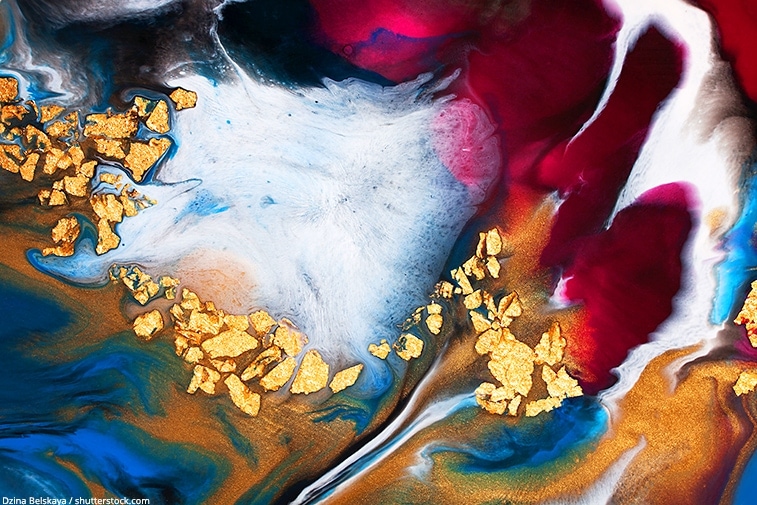
Preparation of the Workplace and Painting Base of operations
Thoughts on Resin Painting Composition
Mixing and Coloring Resin


Casting the Resin Painting


Casting Further Layers
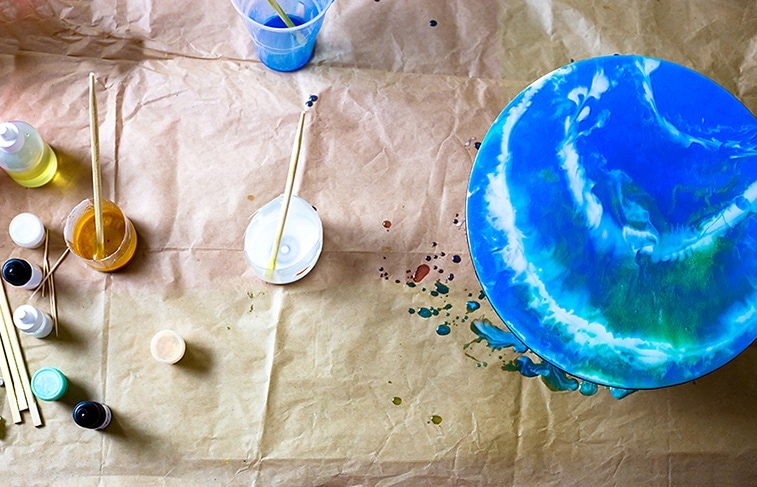
Repair Damages in Your Resin Art
Cleaning the Tools
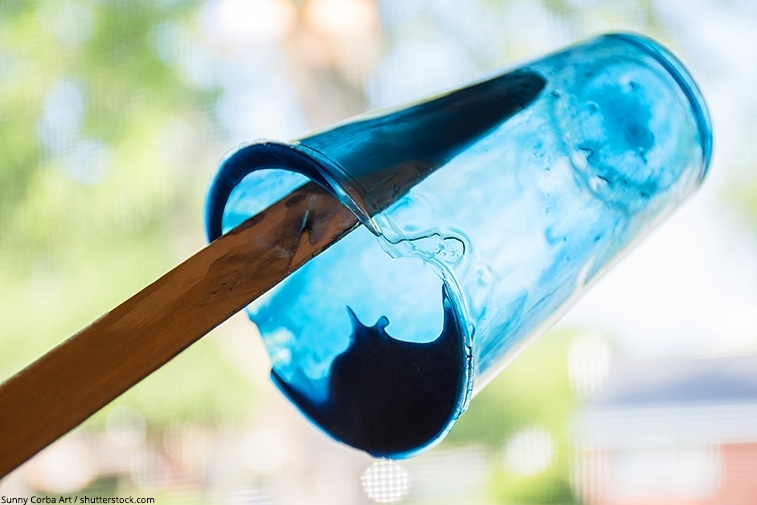
Sealing Resin Art with Epoxy Resin
Comprehend the areas you do not desire to seal with masking record. These could be the edges or the lesser of your canvas, for example. Tips and Tricks
Inspirations for Your Epoxy Art
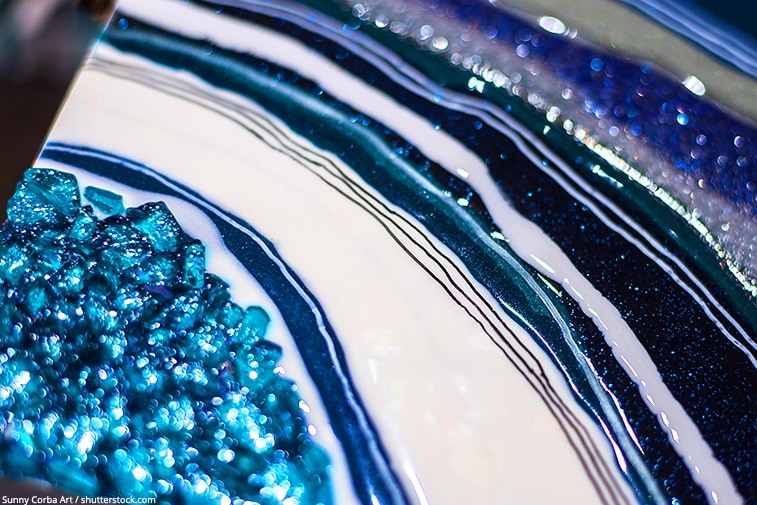
Source: https://fluid-painting.com/en/resin-art/